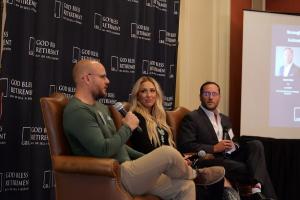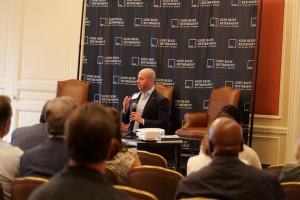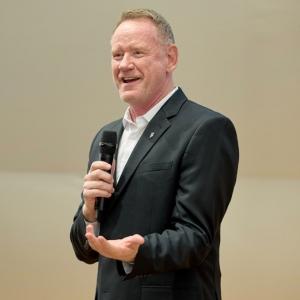Researchers Identify Predictable Audience Threshold for Influencer Marketing Campaigns
Predictable audience threshold helps brands forecast influencer campaign reach and engagement, reducing guesswork and improving ROI planning.
This research gives marketers a data-driven way to forecast influencer campaign impact instead of relying on intuition or follower counts.”
FORT WORTH, TX, UNITED STATES, September 30, 2025 /EINPresswire.com/ -- Marketers have long struggled to know whether their influencer campaigns will actually move audiences or merely rack up vanity metrics. New research from Texas Christian University may change that, offering a statistical framework to predict how far content will travel online and how much engagement it will produce.— Brandon Chicotsky, Ph.D.
The study — published recently by Springer in Advances in Data Analytics for Influencer Marketing: An Interdisciplinary Approach — introduces an analytical model that applies graph theory and regression analysis to map online networks and forecast campaign results. The approach identifies what the authors call an “audience threshold,” the point at which a network of influencers becomes large and connected enough to reliably generate measurable responses such as likes, shares and clicks.
“This work brings needed rigor to an industry that’s exploded in size but often still runs on hunches,” said Brandon Chicotsky, Ph.D., Associate Professor of Professional Practice in Marketing at Texas Christian University and lead author of the study. “Marketers can move beyond raw follower counts and model how engagement will scale before they spend.”
Ken Corbit, Ph.D., a marketing communication specialist and coauthor, said the research bridges a gap between academic insight and practical marketing. “Brands have lacked a clear, repeatable way to forecast the impact of influencers,” Corbit said. “Our framework turns that uncertainty into measurable scenarios.”
Billions at stake in a fast-changing market
Influencer marketing is now estimated at more than $21 billion globally, according to industry trackers, but measuring return on investment remains notoriously difficult. Campaigns often rely on creators with large follower bases under the assumption that reach equates to influence. Yet audiences can be passive, algorithm shifts can derail exposure, and costly posts may fail to spark meaningful interaction.
Marketers also face intense budget scrutiny as advertising dollars tighten and executives demand clearer performance metrics. “The days of writing big checks for vague engagement promises are fading,” said Chicotsky. “Companies want evidence before they commit.”
The research responds to these market pressures by adapting tools long used in mathematics and computer science to the messy world of social media.
How the study worked
Chicotsky and Corbit analyzed one of the internet’s largest publicly available social datasets: the Higgs Boson Twitter (X) network, which tracked millions of posts, retweets, and connections during a viral news event. The dataset offered a rare, transparent look at how information spreads when attention spikes.
Using graph theory, the researchers mapped each user as a node and each interaction as an edge, then calculated degree centrality — a measure of how well a user is connected within a network. High centrality indicates a person’s ability to spread content across clusters of followers.
Next, the team built regression models to quantify how posting activity (tweets, retweets) correlated with actual engagement. They tested different “cutoff points” — such as including only users above a certain centrality — to see when engagement became predictable and statistically significant.
Their results showed that follower count alone is a weak predictor of campaign success. Instead, once a marketer assembles a group of influencers with strong internal connections — even if each has a smaller audience — engagement scales more reliably. This creates a calculable audience threshold: the minimum network size and activity level needed to expect a certain outcome.
“Smaller, well-connected influencers often outperform mega-creators who have lots of followers but limited network impact,” Chicotsky said. “The data lets you test where the tipping point really is.”
A step-by-step playbook:
- The published model outlines a repeatable process:
- Map the conversation. Use social listening or platform data to identify who is talking about your topic or brand.
- Rank by degree centrality. Focus on network connectivity, not just audience size.
- Experiment with cutoffs. Try including influencers above different centrality levels and observe how engagement projections change.
- Run regression analysis. Model how posting activity drives responses such as likes, shares, comments or clicks.
- Refine until projections meet goals. Adjust the influencer mix until predicted engagement aligns with campaign targets.
The result is a quantitative forecast marketers can present before launching — a marked shift from relying on averages or anecdotal case studies.
From research to market conversation
The publication sparked interest beyond academia. Shortly after the study’s release, Chicotsky hosted a professional gathering at the historic Fort Worth Club titled “Strategic Capital & Monetizing Reach: Actionable Insights from Influencers.”
More than 100 professionals — including regional bankers, private equity investors, and advisers who structure and finance deals — attended to explore the economic potential of digital influence. Sponsored by Trellis Energy Partners, the event featured panelists such as enterprise AI architect Jason Hess, media entrepreneur Shaun Overton, and Western lifestyle influencer Morgan Zip, who discussed how content creators build valuable channels and how capital providers evaluate those ventures.
Panelists said frameworks like the one introduced in the TCU research help de-risk investments in emerging media companies and give marketers clearer ROI models.
“The conversation underscored that influencer reach isn’t just a marketing concern anymore — it’s an investment metric,” said Corbit. “Dealmakers want to understand how digital influence converts to measurable value.”
Why it matters for marketers and investors
The findings arrive as social media platforms fragment and executives demand more transparency. Brands looking to work with micro- and mid-tier influencers can use the model to set evidence-based expectations, while agencies can refine pricing and performance guarantees.
Chicotsky said the implications go beyond marketing departments. “If you’re allocating capital to media-driven ventures — whether you’re a bank financing growth or a private equity firm evaluating acquisitions — you need a way to forecast audience traction. This framework gives you a defensible method.”
Industry analysts say that could reshape how contracts with influencers are structured, how budgets are approved, and even how digital brands are valued during mergers or acquisitions.
Room to expand
The researchers note that the model was validated on Twitter data but is platform-agnostic and can be adapted to Instagram, TikTok, YouTube, or LinkedIn where interaction data is accessible. Future refinements could incorporate content quality, audience demographics, and algorithmic exposure.
For now, the study represents one of the clearest attempts to merge data science and marketing strategy in a way business leaders can apply.
“Marketers have wanted a way to take the guesswork out of influencer campaigns,” Corbit said. “This isn’t magic — it’s math that works in the real world.”
Publication details
The work appears in Advances in Data Analytics for Influencer Marketing: An Interdisciplinary Approach, a Springer academic volume in an initial release in late 2024 and circulated in fall 2025. Chicotsky, B. & Corbit, K. An Audience Threshold in the Millions: Exploring Influencer Marketing Activations Online. NY: Springer Publishers. ISBN 978-3-031-65726-9.
Brandon Chicotsky, Ph.D.
TCU Neeley School of Business
b.chicotsky@tcu.edu
Visit us on social media:
LinkedIn
X
Legal Disclaimer:
EIN Presswire provides this news content "as is" without warranty of any kind. We do not accept any responsibility or liability for the accuracy, content, images, videos, licenses, completeness, legality, or reliability of the information contained in this article. If you have any complaints or copyright issues related to this article, kindly contact the author above.



